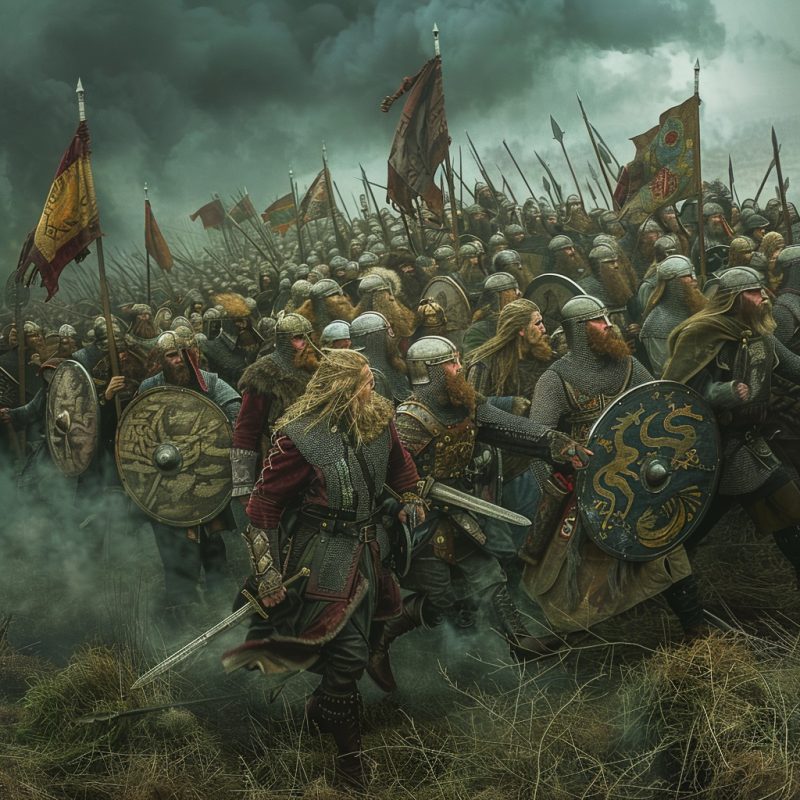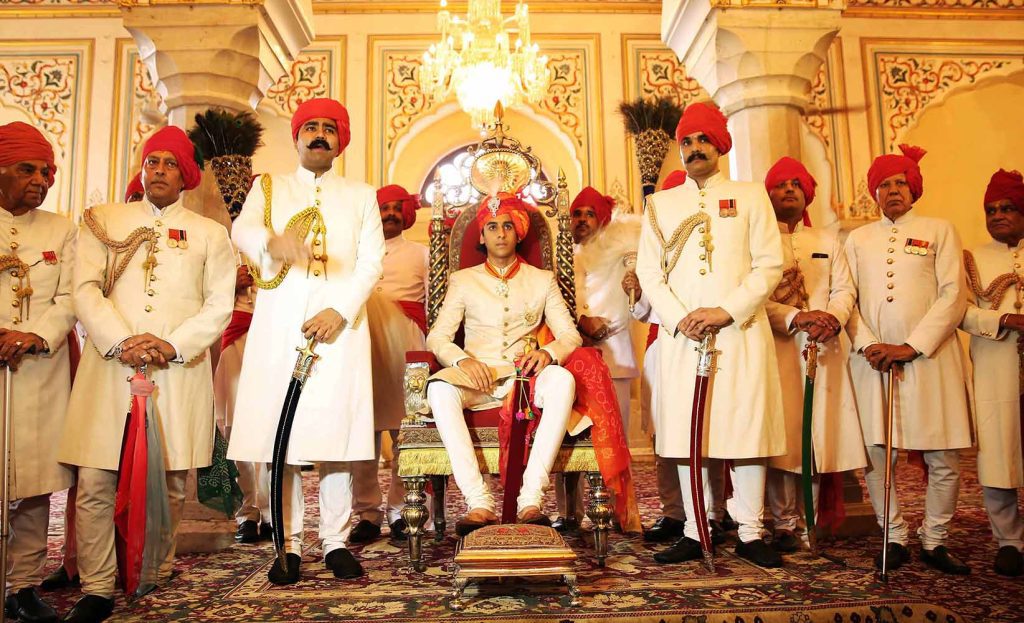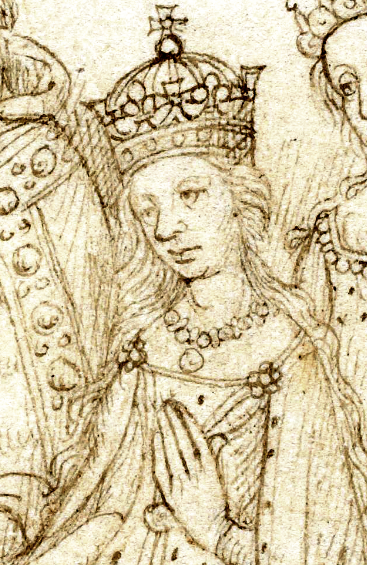Bold, courageous, and feared throughout the lands, Halfdan Ragnarsson stands as a legendary figure in Viking history.
The period between the late 8th and early 11th century, known as the Viking Age, was characterized by the widespread expansion and exploration of the Norse seafarers. This era saw the Vikings raiding and carrying out trade across vast distances, forming settlements, and shaping the socio-political scenarios of numerous regions like the British Isles and some parts of Europe. Their significant historical impact continues to fascinate people globally.
This highly volatile era features Halfdan Ragnarsson as one of its pivotal figures. A leader and warrior, he had a notable role in the Viking invasions that drastically altered England’s political landscape and reached even further. His strategies and deeds as the Great Heathen Army’s commander underscore the immense power of Viking leaders and their enduring influence on European history.
In this article, we explore the life of Halfdan Ragnarsson, focusing on his ancestry and early years, his part in the Viking conquests, and his enduring legacy. Through this examination, we aim to deepen our understanding of Halfdan Ragnarsson’s significant role in influencing Northern European history.
Halfdan Ragnarsson’s Early Life and Background
Lineage and Family
Halfdan Ragnarsson’s family is woven into the very fabric of Norse mythology and legend. He was the son of Ragnar Lodbrok, one of the most famous Viking leaders of all time, whose exploits are told and retold in the sagas and historical accounts. Ragnar Lodbrok’s stories of adventure and plunder have made him a central character in Viking mythology. Halfdan’s mother Aslaug Sigurdsdottir was also a main player in these stories, often portrayed as a wise and beautiful woman of noble birth.
Halfdan wasn’t the only one of the clan who would become a legend; he had several brothers who were just as famous. Among them were Ivar the Boneless, known for his cunning and tactical mind; Sigurd Snake-in-the-Eye, who got his name from the apparent snake marking in his eye; and Ubbe Ragnarsson, another fierce warrior. Together with Halfdan, they were a force to be reckoned with in Viking history, each adding to their father Ragnar Lodbrok’s legend.
Historical Context
The Viking Age revolved around energetic and frequently harsh interactions with the rest of Europe. The Scandinavian region was a mosaic of kingdoms and chieftains, each competing for power and resources. The societal and political terrain was characterized by perpetual strife, alliances, and a culture that valued military skill and exploration.
Initially, Viking raids were irregular and opportunistic, but they gradually became more structured and ambitious. Factors such as overpopulation, political instability, and the attraction of wealth from more established and prosperous areas drove these raids. The Vikings’ maritime skills allowed them to conduct rapid and lethal attacks over great distances, instilling terror in their adversaries.
The formation of the Great Heathen Army, a coalition of Viking warriors helmed by Ragnar Lodbrok’s sons, was a significant event in this era. Their campaigns significantly altered the political makeup of Anglo-Saxon England. The invasions were driven by various motives, from avenging Ragnar’s death to seeking new territories and wealth.
The Viking invasions in Europe, specifically in the British Isles, were not merely for looting, but also for domination and colonization. The repercussions of these attacks were significant, leading to substantial shifts in the cultures and political landscapes of the impacted regions. The Vikings profoundly influenced European history, impacting everything from local governance to cultural customs.
The Great Heathen Army
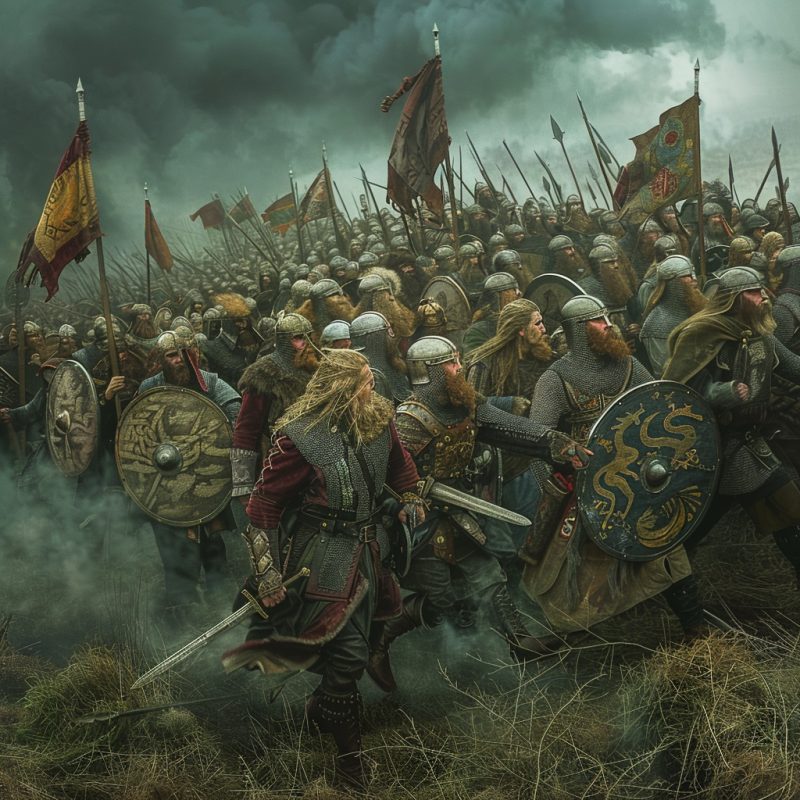
Formation and Leadership
The Great Heathen Army, also referred to as the Great Viking Army, was a group of Scandinavian warriors who began their invasion of England around 865 AD. This group differed from previous Viking raiders, who were more concerned with seasonal raids and plundering. The Great Heathen Army had larger goals in mind – to conquer England and establish a settlement there. Several Viking chieftains, primarily the sons of Ragnar Lodbrok, assembled this army in retribution against King Ælla of Northumbria, who had sentenced Ragnar to death by throwing him into a snake pit.
Halfdan Ragnarsson was one of the main leaders of this massive force. He was the one who organized and led the army’s campaigns across England. Along with his brothers Ivar the Boneless and Ubbe, Halfdan was part of the planning and execution of the military campaigns that would shape the Anglo-Saxon kingdoms. Halfdan was a tactician and could inspire and manage a bunch of warriors with different backgrounds united by one goal – conquest and settlement.
Invasion of England
In 865 AD, the Great Heathen Army initiated their invasion of East Anglia, a campaign that would last several years. Caught unprepared for an assault of this magnitude, the East Anglians chose peace, providing the Vikings with horses. This greatly facilitated their movement, enabling them to swiftly expand their territory.
In 866, the military advanced northward and captured the city of York, a significant victory that solidified their control over Northumbria. The seizure of York marked a pivotal moment, providing the Vikings with a fortress and operational base. The subsequent year, King Ælla of Northumbria and his competitor, Osberht, attempted to reclaim the city but were unsuccessful. Viking sagas report that King Ælla underwent the blood eagle, a horrifying ritualistic execution that reinforced the Vikings’ brutal reputation and their thirst for vengeance.
Halfdan Ragnarsson and his brothers, after seizing Northumbria, shifted their focus to Mercia. In 868, they conquered the town of Nottingham, leading King Burgred of Mercia to seek assistance from Wessex. Even though the Mercian and West Saxon armies teamed up, the Vikings managed to retain control of Nottingham. Ultimately, they negotiated a peace deal and demanded tribute from the local rulers.
By 874 the Great Heathen Army had subdued Mercia, deposed its king Burghred and installed a puppet ruler. The division of Mercia into areas controlled by the Vikings and their allies solidified the Norse presence in England. The army was then divided with Halfdan taking his forces north to continue the campaigns against the Picts and the Britons of Strathclyde and Guthrum to Wessex.
The campaigns and leadership of Halfdan Ragnarsson were crucial in enabling the Vikings to seize control of vast areas of England. The territory they acquired was not just affluent, but also provided a platform for further expansion and settlement, thus altering the political and cultural makeup of the British Isles.
Conquests and Campaigns
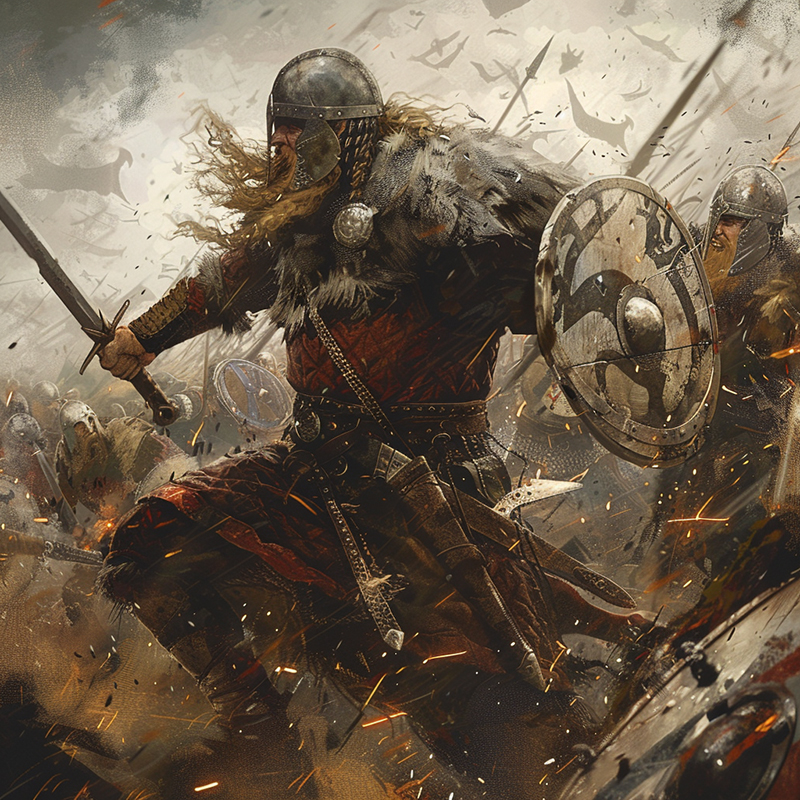
Battles and Military Strategies
Halfdan Ragnarsson’s military career is marked by several significant battles and campaigns that highlight his strategic prowess and leadership. One of the major battles during his time was the Battle of Ashdown in 871. This was part of the larger conflict between the Vikings and the Anglo-Saxons under King Æthelred and his brother Alfred (later Alfred the Great). The Vikings lost at Ashdown but regrouped and continued to raid Wessex.
Halfdan frequently employed strategies that capitalized on the speed and element of surprise of their ships and mounted troops. The Vikings excelled at detecting vulnerabilities in their adversaries’ defenses and utilized their maritime abilities to initiate unforeseen assaults. They had the capacity to attack and withdraw as necessary, keeping their opponents unsteady on various fronts.
After their battles in Wessex, Halfdan’s forces were reinforced by the Great Summer Army led by another Viking leader, Bagsecg. This made the Viking army stronger and led to several indecisive battles, such as Basing and Meretun. Despite the fierce resistance from the Anglo-Saxons, Halfdan’s forces won the battle of Meretun where King Æthelred was killed and Alfred became the new king.
Both sides suffered due to continuous warfare, leading to a truce in which the Vikings agreed to leave Wessex in exchange for payment. Nonetheless, this did not signify the cessation of their campaigns. They kept targeting other regions, indicating Halfdan’s unwavering quest for expansion and domination.
Expansion into Ireland and Scotland
Halfdan Ragnarsson’s aspirations extended beyond England. Once he established Viking dominance in certain areas of England, he shifted focus to Ireland and Scotland. Specifically in Ireland, he sought to reclaim Dublin, a city that had previously been under the rule of several Viking leaders, including his brother, Ivar the Boneless. Following Ivar’s death, Dublin came under the rule of Eystein, son of Olaf the White. However, Halfdan contested Eystein’s reign.
Halfdan’s endeavor to reclaim Dublin resulted in disputes with the “Fair Heathens” – a moniker for the Vikings who had previously settled in Ireland and set up their own power hierarchies. This intra-Viking conflict reached its peak in the 877 Battle of Strangford Lough, where Halfdan met his end. His demise represented a crucial shift, as it obstructed him from reasserting his authority over Dublin and greatly influenced Viking political dynamics in the area.
Halfdan Ragnarsson’s campaigns in Scotland expanded Viking influence into Pict and British areas. These campaigns included both combat and negotiations with local leaders. Halfdan extended Viking influence into Scotland and Wales through forming alliances and applying military pressure, demonstrating his tactical and diplomatic abilities.
Halfdan’s explorations in Ireland and Scotland demonstrate his broader perspective on Viking expansion, beyond the initial invasions in England. He skillfully maneuvered through the intricate politics of these regions, demonstrating his ability to both fight and negotiate. His leadership and strategic abilities were commendable.
In summary, Halfdan Ragnarsson’s victories and military campaigns were pivotal in the spread of Vikings across the British Isles. His tactical warfare and attempts to assert dominance over vital territories considerably influenced the regional political landscape during the Viking Era.
Rule and Governance
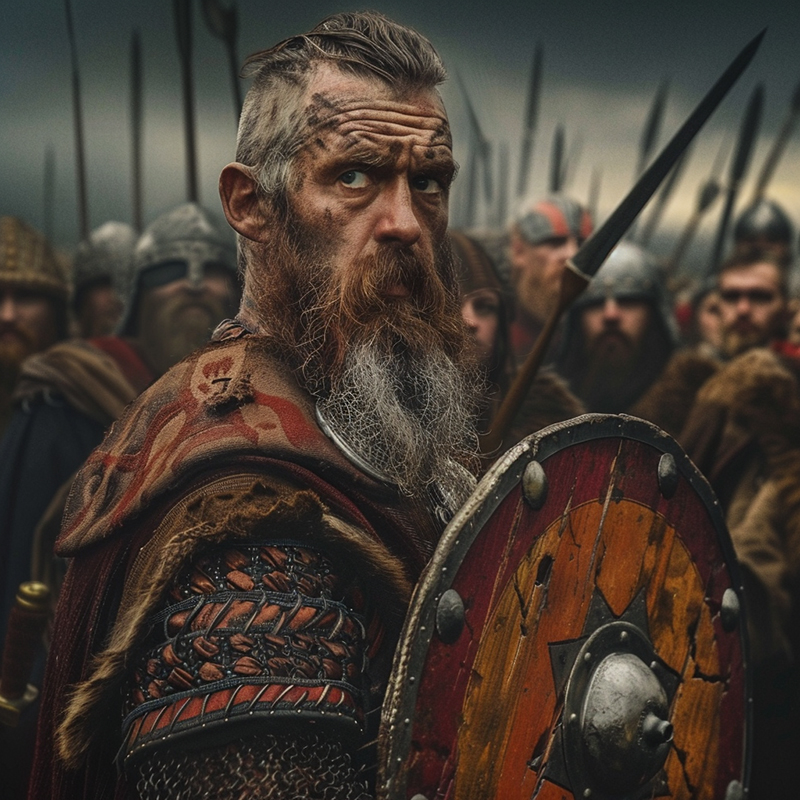
Establishment of Viking Rule
The reign of Halfdan Ragnarsson in Northumbria represents a notable era of Viking dominion in England. After securing military victories, most notably the seizure of York, Halfdan asserted himself as a leader and introduced Viking laws and traditions to the region. His rule was defined by the enforcement of Danelaw, a hybrid of Viking and Anglo-Saxon laws. This legal system streamlined the administration of territories and ensured harmony among the varied populations under Viking rule.
The reign of Halfdan Ragnarsson was focused on managing resources and maintaining social order. He established administrative hubs and ensured the collection of taxes and tributes. This was crucial in strengthening Viking dominance and unifying the conquered territories. Halfdan’s strategic leadership led to the prosperity of these territories, capitalizing on both Viking trade routes and local farming production.
Cultural and Social Impact
Halfdan’s impact was not confined to governance; he was instrumental in moulding the Viking culture in the territories under his control. His sponsorship of arts and crafts resulted in a boom of Viking artistic endeavours such as detailed metalwork, wood sculptures, and jewellery. These cultural pieces represented a fusion of Norse and Anglo-Saxon customs, forming a distinct cultural amalgamation.
Halfdan Ragnarsson significantly contributed to the development of the Thing, a governing entity where issues were resolved and choices were made. It was more than a court, serving as a social establishment that united the community and ensured justice for everyone. The Thing laid the groundwork for the Viking government, instilling a sense of order and communal decision-making that would be inherited by future generations.
Halfdan Ragnarsson’s Death and Legacy
Death at the Battle of Strangford Lough
The pivotal moment in Viking history was marked by the death of Halfdan Ragnarsson in 877, during the Battle of Strangford Lough. He was defeated and killed in this battle, which was fought against rival Viking factions referred to as the “Fair Heathens.”
Halfdan’s attempts to take back Dublin and establish his dominance in Ireland led to this conflict. His death not only put a stop to his Irish ambitions but also left a power void that impacted Viking dominance in the area.
The demise of such an influential leader unsettled Viking strategies, causing a phase of instability and power reshuffling among Viking chiefs.
Historical and Cultural Legacy
The legacy of Halfdan Ragnarsson is extensive. His military victories and leadership set the standard for Viking rule in some parts of England, forever altering the political scene. His command of the Great Heathen Army showcased the Vikings’ ability to conduct organized, large-scale military operations that went beyond simple raids.
His cultural influence is evident in the blend of Norse and Anglo-Saxon traditions that enhanced the cultural tapestry of the regions under his control. The artifacts and customs from his era continue to be celebrated and examined today, providing insights into Viking life and rule.
Halfdan’s legacy is kept alive today through his various depictions in media, literature, and popular culture. His influence remains evident in historical dramas, novels, and video games, underscoring his enduring impact on our collective imagination. While sometimes these portrayals can be dramatized, they underscore the interest in Viking history and the crucial role individuals like Halfdan had in forming it.
Halfdan Ragnarsson is a pivotal character in the annals of Viking history. He embodies the intricacies of Viking rule, invasion, and cultural assimilation. His existence and legacy remain a fascinating and motivational subject, highlighting the significant influence the Vikings wielded on the trajectory of European history.
Historical Debate and Interpretation
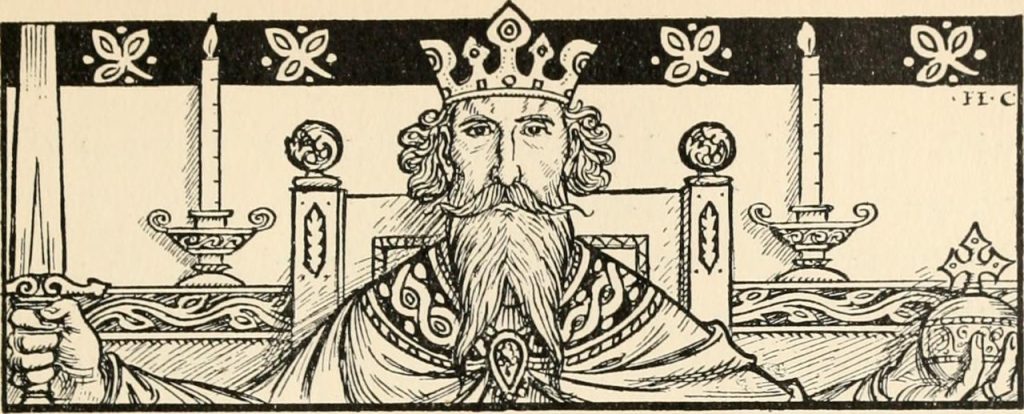
Historical Sources and Evidence
The historical narrative of Halfdan Ragnarsson’s life and achievements is pieced together from various primary sources and archaeological evidence. Key among these sources are the Annals of Ulster and the Anglo-Saxon Chronicle. The Annals of Ulster, a chronicle of medieval Ireland, provides valuable insights into Viking activities in Ireland and Scotland, including Halfdan’s campaigns and his eventual death at the Battle of Strangford Lough. These annals offer a contemporary account of events, adding a layer of authenticity to the historical record.
Another source documenting the Viking invasions and their effects on Anglo-Saxon England is the Anglo-Saxon Chronicle. This detailed account, written during the rule of Alfred the Great, covers the battles and political shifts resulting from the Viking raids. It highlights the Viking’s capture of York, their control over Northumbria and Mercia, and Halfdan’s role in these events.
Archaeological findings also provide insight into the era of Halfdan Ragnarsson. Digging in York, a key Viking stronghold, has revealed artifacts and structures that demonstrate the existence and lifestyle of the Vikings. These discoveries, such as Viking fortifications, tools, and daily-use items, offer a peek into the administrative and cultural customs of the Viking period.
Interpretations and Controversies
Academic perspectives on Halfdan Ragnarsson’s life and accomplishments are diverse due to the challenges of interpreting historical documents and myths. Some historians highlight his military prowess and strategic intellect, viewing him as integral to the Viking expansion across the British Isles. However, others question his exact contributions, noting the difficulty in determining his precise actions due to the scattered nature of Viking records. This is further complicated by the fact that myths and even propaganda were used in historical record keeping of the time to validate claims or even alter historical narratives to favor a particular group or nation.
A significant controversy in Viking history revolves around the historicity of Ragnar Lodbrok and his sons, including Halfdan. While Ragnar is a central figure in Norse sagas, some scholars argue that he is a composite character, blending various historical and mythical elements. The existence of his sons, including Halfdan Ragnarsson, is better documented, but their familial relationships and individual exploits are often intertwined with legend, complicating the historical narrative.
This debate, however, goes beyond just this, extending to an overall interpretation of their accomplishments. Some researchers see the sagas as significant historical resources that offer an understanding of Viking society and values. Conversely, others warn about accepting these narratives without scrutiny, promoting a more discerning analysis of the existing evidence.
Conclusion
The life and times of Halfdan Ragnarsson offer a glimpse into the vibrant and ruthless world of the Viking Age. As a commander of the Great Heathen Army, Halfdan’s pivotal role in the Viking conquests significantly altered the political scene of England and other regions. His military tactics, rule, and cultural impact had a profound and enduring effect on the territories under his command.
Reflecting on Halfdan’s Viking history reveals a multifaceted legacy. His conduct exemplifies the aspirations and expansionist tendencies of Viking leaders, and his rule illustrates the fusion of Norse and local traditions. The mixed narrative of Halfdan’s story, a blend of myth and history, continues to captivate and motivate, emphasizing the persistent fascination with Viking culture.
To sum it up, the legacy of Halfdan Ragnarsson persists through historical documents, archaeological discoveries, and contemporary analyses. His life serves as a portal to the Viking Age, offering significant understanding of the social, political, and cultural dynamics of that period.
Halfdan Ragnarsson, a notable figure of his era, continues to have a substantial impact on Viking history. His story persists as a source of fascination and academic curiosity.

